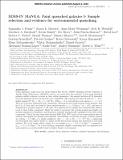SDSS-IV MaNGA: faint quenched galaxies I- sample selection and evidence for environmental quenching
Abstract
Using kinematic maps from the Sloan Digital Sky Survey (SDSS) Mapping Nearby Galaxies at Apache Point Observatory (MaNGA) survey, we reveal that the majority of low-mass quenched galaxies exhibit coherent rotation in their stellar kinematics. Our sample includes all 39 quenched low-mass galaxies observed in the first year of MaNGA. The galaxies are selected with Mr > -19.1, stellar masses109 M⊙ < M⋆ < 5 ×109 M⊙, EWHα < 2 Å, and all have red colours (u - r) > 1.9. They lie on the size-magnitude and σ-luminosity relations for previously studied dwarf galaxies. Just six (15 ± 5.7 per cent) are found to have rotation speeds ve, rot <15 km s-1 at ~ 1Re, and may be dominated by pressure support at all radii.Two galaxies in our sample have kinematically distinct cores in their stellar component, likely the result of accretion. Six contain ionised gas despite not hosting ongoing star formation, and this gas is typically kinematically misaligned from their stellar component. This is the first large-scale Integral Field Unit (IFU) study of low mass galaxies selected without bias against low-density environments. Nevertheless, we find the majority of these galaxies are within ~1.5 Mpc of a bright neighbour (MK < -23; or M⋆ > 5 × 1010 M⊙), supporting the hypothesis that galaxy-galaxy or galaxy-group interactions quench star formation in low-mass galaxies. The local bright galaxy density for our sample is ρproj = 8.2 ± 2.0 Mpc-2, compared to ρproj = 2.1 ± 0.4 Mpc-2 for a star forming comparison sample,confirming that the quenched low mass galaxies are preferentially found in higher density environments.
Citation
Penny , S J , Masters , K L , Weijmans , A-M , Westfall , K B , Bershady , M A , Bundy , K , Drory , N , Falcón-Barroso , J , Law , D , Nichol , R C , Thomas , D , Bizyaev , D , Brownstein , J R , Freischlad , G , Gaulme , P , Grabowski , K , Kinemuchi , K , Malanushenko , E , Malanushenko , V , Oravetz , D , Roman-Lopes , A , Pan , K , Simmons , A & Wake , D A 2016 , ' SDSS-IV MaNGA: faint quenched galaxies I- sample selection and evidence for environmental quenching ' , Monthly Notices of the Royal Astronomical Society , vol. 462 , no. 4 , pp. 3955-3978 . https://doi.org/10.1093/mnras/stw1913
Publication
Monthly Notices of the Royal Astronomical Society
Status
Peer reviewed
ISSN
0035-8711Type
Journal article
Description
SJP acknowledges postdoctoral funding from the University of Portsmouth. AW acknowledges support of a Leverhulme Early Career Fellowship. This work was supported by World Premier International Research Center Initiative (WPI Initiative), MEXT, Japan. J. F-B. acknowledges support from grant AYA2013-48226-C3-1-P from the Spanish Ministry of Economy and Competitiveness (MINECO), as well as from the FP7 Marie Curie Actions of the European Commission, via the Initial Training Network DAGAL under REA grant agreement number 289313. MAB acknowledges support from NSF AST 1517006.Collections
Items in the St Andrews Research Repository are protected by copyright, with all rights reserved, unless otherwise indicated.

